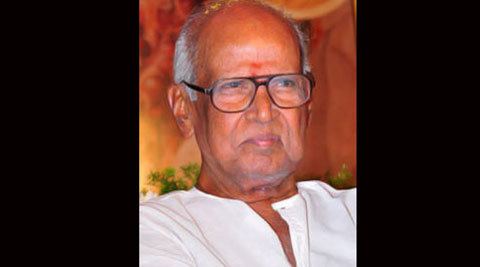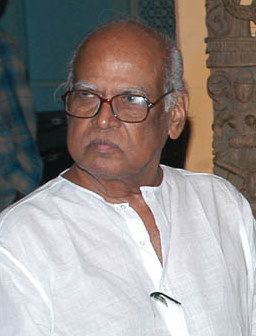Name Sattiraju Narayana Alma mater University of Madras Education University of Madras Died August 31, 2014, Chennai | Role Film director Website bapuartcollection.com Books Bommalu giyandi | |
 | ||
Full Name Sattiraju Lakshminarayana Born 15 December 1933 ( 1933-12-15 ) Narasapuram, Madras Presidency, British India(now in Andhra Pradesh, India) Parents Surya Kantham, Sattiraju Venugopala Rao Movies Sri Rama Rajyam, Pelli Pustakam, Gorantha Deepam, Mantri Gari Viyyankudu, Mutyala Muggu Similar People Asaram, Mullapudi Venkata Ramana, K V Mahadevan, Akkineni Nageswara Rao, Allu Rama Lingaiah | ||
Bapu film director telugu movie hit songs jukebox
Sattiraju Lakshmi Narayana (15 December 1933 – 31 August 2014), known professionally as Bapu, was an Indian film director, and screenwriter known for his works in Telugu cinema, and bollywood. He was also a music artist, painter, illustrator, cartoonist, and designer. In 2013, he was awarded the Padma Shri, for his contribution to Indian art and cinema.
Contents
- Bapu film director telugu movie hit songs jukebox
- director bapu jayanthi special
- Early life and background
- Painting
- Cinematic style
- Association with Ramana
- Collaborations with other artists
- Hindi cinema
- Death
- Awards and honours
- Filmography
- References

Bapu's directorial venture Saakshi was showcased at Tashkent International film festival in 1968. Seeta Kalyanam was screened at the BFI London Film Festival, Chicago International Film Festival, San Reno and Denver International Film Festivals in 1978, and is part of the course at the British Film Institute. Tyagayya (1981) and Pelli Pustakam (1991) were premiered at the Indian Panorama of the International Film Festival of India. Bapu's 2011 film Sri Rama Rajyam had a special screening at International Film Festival of India on 28 November 2011.
He has garnered two National Honors, two National Film Awards, seven state Nandi Awards, two Filmfare Awards South best Telugu director, and a Filmfare Lifetime Achievement Award – South for the year 2012. In 1996, He has appeared in the Doordarshan Documentary Eminent Cartoonists of India, and was awarded Life Time Achievement from Indian Institute of Cartoonists in 2001. He gained international recognition through his art works viz., Bapu Bomma, The Navarasas, and the Indian Dances etc., which were held at the National Film Theatre, London, in 1978 and at the innumerable Telugu Conferences in the United States. He has worked as a graphic artist for J Walter Thomson, Efficient Publicities and F. D. Stewarts, Chennai.
In 1964, He was a delegate at the UNESCO sponsored seminar in Bangalore on Children's Books. The same year, he gave demonstrations for the training course programme on book illustrations and cover designs sponsored by UNESCO in Chennai. In 1960's he has served as art Consultant for Ford Foundation sponsored The Southern Language Book Trust. He has designed and illustrated several books for leading publishers in South India out of which, five received Government Awards. He has also done the same for innumerable works drawn from the puranas and folklore.

director bapu jayanthi special
Early life and background

Bapu was born on 15 December 1933, in Narsapur, in present-day West Godavari district, Andhra Pradesh, India to Sattiraju Venugopala Rao and Suryakantam. He has worked as a political cartoonist for the newspaper Andhra Patrika in 1945. He holds B.Com (1953) and BL (1955) from University of Madras.
Painting
Bapu introduced a painting style of simple bright colours. His unique style consisted of economy of strokes, freehand drawing and a lack of background clutter.
His paintings focus on Hindu mythological characters, and he has painted the Hindu epic Ramayana as a pictorial story. His character portrayals, such as Shiva, Bhima, Duryodhana, look distinctly male with wide chests, large jaws and large biceps; while Krishna and Rama are more feminine in build. Bapu has also introduced a new style of cursive writing in Telugu. The font is his own handwriting and reflects the same simplicity as his art.
Bapu's paintings also decorated the cover pages of many magazines in India and Abroad. Telugu Naadi Magazine published from USA for Telugu audience have published Bapu's great paintings. Bapu also later served on their advisory board to guide and have an outstanding content for the magazine that catered to Telugu people.
Cinematic style
The most notable achievement in Bapu's movie making is his success in capturing the nativity of the Telugu people and translating it into visuals. His movies center on realistic family issues and relationships, however his recurring theme is magic realism, with vignettes of mythological characters aiding in the narration.
Most of his movies have a female protagonist; a breakaway style from the formulaic movies that relegate female lead characters to song and dance numbers. His penchant for preserving the Telugu nativity in his movies can be seen in the choice of artists, especially the dusky female leads and weak villains.
Association with Ramana
Bapu's family was staying in Madras and in 1942, when the Japanese bombed Madras, there was a panic exodus and Bapu's family moved to Narasapuram and stayed there till 1945, when the Second World War ended. Bapu studied in Taylor High School, Narasapuram during these years. Mullapudi Venkataramana's father, who was working as a Sub-Registrar was posted at Narasapuram during the years 1942-45 and so, Venkataramana also studied in Taylor high School, Narasapram, during those years. They were classmates during those three years and that is how their association started. They continued schooling at Kesari High School, Madras. Ramana's first short story 'Amma Maata Vinakapote' was published in 1945 in 'Bala', a children's magazine published by Radio Annayya (Nyayapathi Raghava Rao), he was 14 then. Bapu illustrated the story. That was the beginning of their career as a writer-producer -illustrator- filmmaker duo".
Started as an illustrator-story writer team and then turning into a film-director-writer duo, they have contributed immensely to the enrichment of Telugu cultural ethos through literature and cinema. When one mentions Bapu, then one is bound to mention Ramana's name too and vice versa. The most notable achievement in his movie making is his success in capturing the nativity of Telugu people and translating it great on-screen visuals. When ever the renowned duo of Bapu and Ramana come together for a project, viewers expect a spectacular visual of nativity with an equally enthralling story-line.
Their mythological ventures like Sampoorna Ramayanam, Ramanjaneya Yuddham and Seeta Kalyanam have been the milestones of Telugu cinema, while historical films like Thyagayya, Bhakta Kannappa and Shreenatha kavisarvabhouma have been hugely successful. Bapu-Ramana combination has created movie magic on the large screen with some of the path breaking films in Telugu cinema and are ever remembered for films like Radha kalyanam, Velugu needalu, Bharyabhartalu, Bhogimanta, Mutyala Muggu, 'Sakshi, Mr. Pellam', Pelli Pustakam. The duo directed Mana Voori Pandavulu (1978) which won the Filmfare Award for Best Film - Telugu.
Collaborations with other artists
He worked with Satyam Sankaramanchi and drew 101 pictures for each of the stories in Amaravati Kathalu. Bapu is one-half of the Bapu-Ramana (Mullapudi Venkata Ramana) pair that made movies in Telugu cinema. Ramana provided an able foil, providing script and dialogue to suit Bapu's visuals. Bapu collaborated with Ramana to give life to Ramana's child prodigy character Budugu in the form of appealing caricatures.
Hindi cinema
Known for introducing Anil Kapoor to Indian cinema, Bapu has directed Hindi films such as Hum Paanch, Prem Pratigyaa,Seeta Swayamvar, Anokhi Bhakt, Bezubaan, Woh Saat Din, Pyari Behna, Mohobbat, Mera Dharam, and Diljala. He has also directed a Tamil film Neeti Devan Mayagugiran.
Death
Bapu had suffered heart attacks many times throughout his career. He was admitted into a hospital at Chennai in mid August 2014. He suffered from a cardiac arrest on 31 August 2014, and died later on the same day. He was given a state funeral by the Government of Andhra Pradesh.
Awards and honours
Filmography
- Ramayanam along with Ramana garu. This book was published in Telugu, English and French languages.
- Maha Bharatam along with Ramana garu.
- Bapu Ramaneeyam along with Ramana garu
- Koti Kommachi along with Ramana garu
- (Im)Koti Kommachi along with Ramana garu
- Kosaru Kommachi -Bapu Ramaneeyam along with Ramana garu
- Bapu Cartoonulu -1
- Bapu Cartoonulu -2
- Bommalu Geeyandi
- Budugu along with Ramana garu
